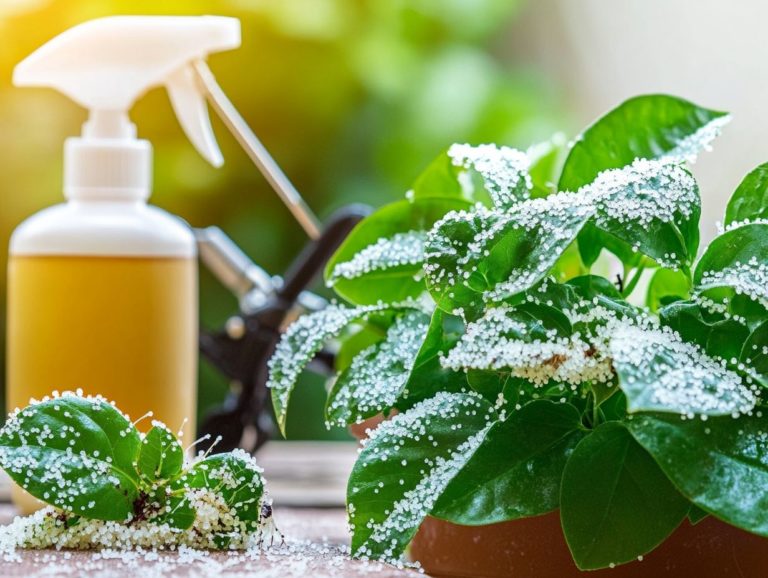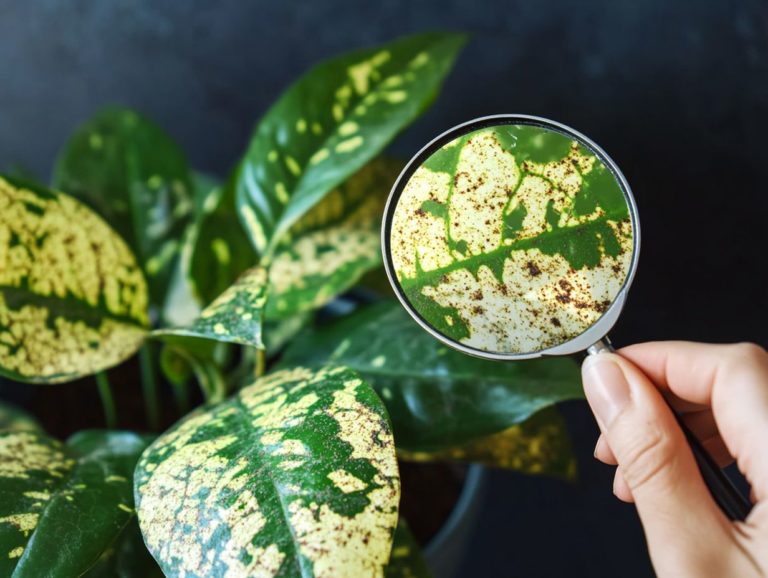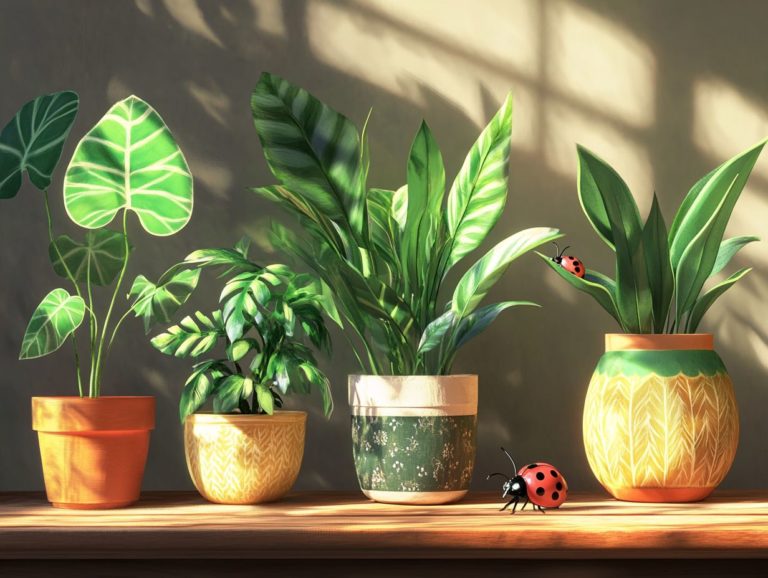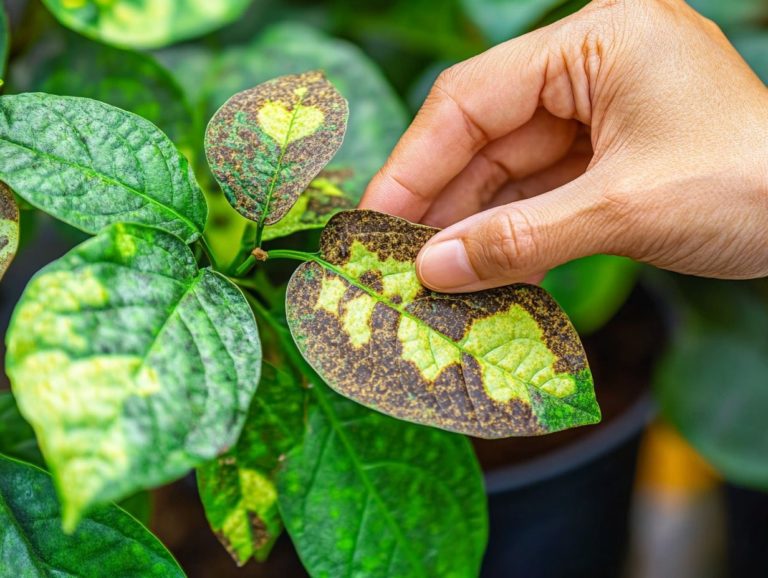5 Signs of Spider Mites in Indoor Plants
Spider mites have a knack for wreaking havoc on indoor plants, often flying under the radar until they’ve caused substantial damage. Be vigilant for five key signs of infestation, including yellow or brown spots on leaves and the tiny mites themselves.
Uncover how these pests spread, familiarize yourself with common types of spider mites, and explore effective natural and chemical treatments. Discover preventive measures to ensure your plants remain healthy and thriving. Don t let spider mites take control of your indoor garden!
Contents
- Key Takeaways:
- 1. Yellow or Brown Spots on Leaves
- 2. Fine Webbing on Leaves and Stems
- 3. Stunted Growth or Wilting Leaves
- 4. Visible Tiny Mites on the Plant
- 5. Plant Leaves Become Brittle and Fall Off Easily
- How Do Spider Mites Affect Indoor Plants?
- Frequently Asked Questions
- What are Spider Mites and Why They Harm Indoor Plants?
- What are the 5 Signs of Spider Mites in Indoor Plants?
- How Can I Confirm the Presence of Spider Mites in My Indoor Plants?
- Can Spider Mites Spread to Other Indoor Plants?
- What is the Best Way to Get Rid of Spider Mites in Indoor Plants?
- How Can I Prevent Spider Mite Infestations in My Indoor Plants?
Key Takeaways:
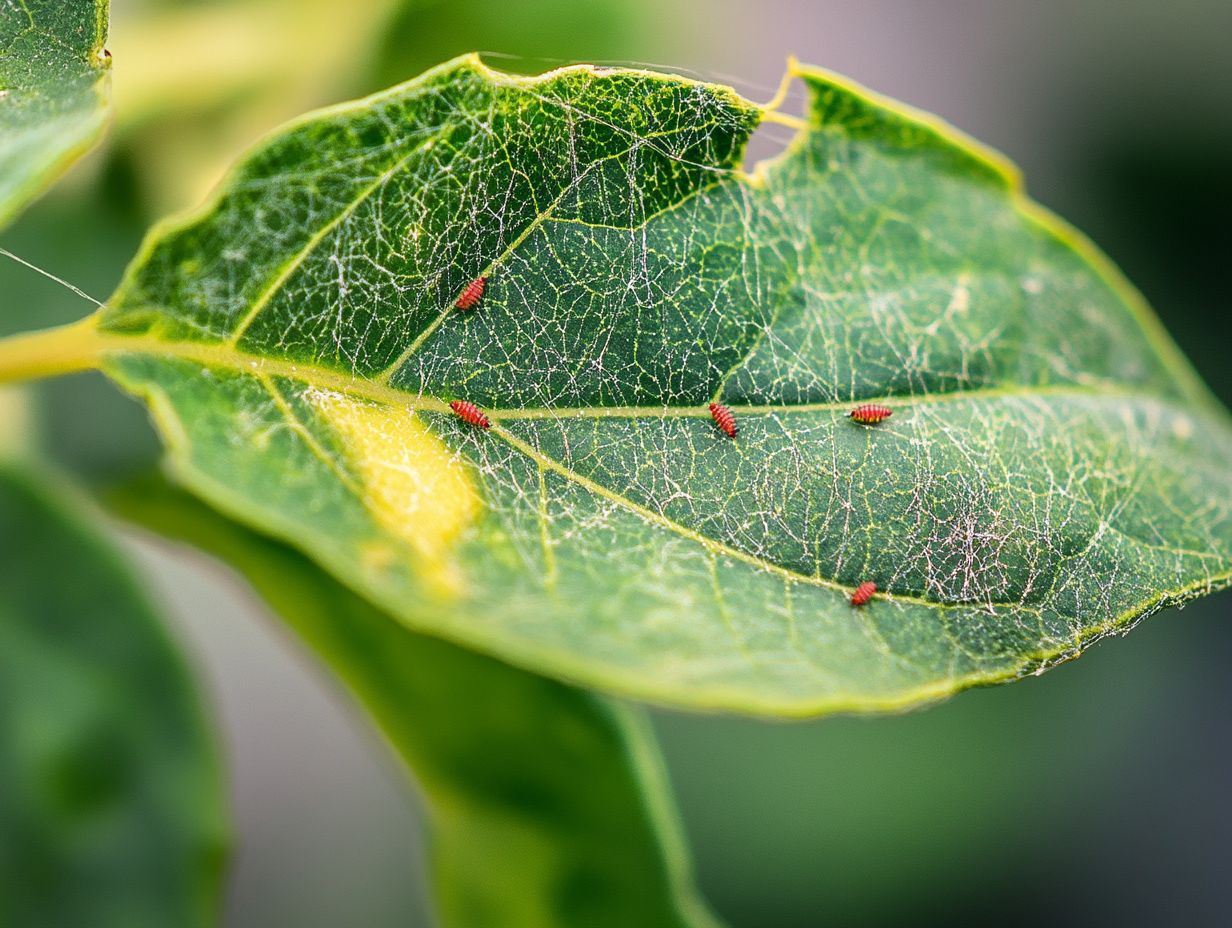
- Look for yellow or brown spots on leaves; they might indicate spider mites.
- Check for fine webbing on your plants; it’s a clear sign of spider mite activity.
- Stunted growth or wilting leaves? Investigate for spider mites immediately!
1. Yellow or Brown Spots on Leaves
Yellow or brown spots on the leaves of your indoor plants, such as Alocasia, Philodendron, and Ficus religiosa, raise concerns for any plant parent. These discolorations might signal a potential spider mite infestation or other issues needing your immediate attention.
Initially, these spots may appear as mere dots but can quickly escalate, leaving your foliage looking mottled and unwell. Spider mites thrive in dry conditions and often leave fine webbing on the underside of leaves a clear indicator of their presence. Other pests, like aphids or mealybugs, can also weaken your plants due to sap depletion.
To combat these threats, regularly clean your leaves with a damp cloth to remove any pesky invaders. Increasing humidity levels around your plants can deter future infestations. By inspecting your plants and maintaining a clean environment, you enhance their resilience and promote robust growth.
2. Fine Webbing on Leaves and Stems
Fine webbing on leaves and stems indicates a two-spotted spider mite infestation, which can severely affect your indoor plants’ health if not addressed promptly.
These tiny pests, often less than a millimeter in size, are identifiable not only by their webbing but also by the stippling they inflict on the leaves those tiny yellow or white dots are a telltale sign. Understanding their life cycle is vital; each female can lay hundreds of eggs, leading to rapid infestations.
If you notice signs of damage, act quickly. Use treatments that work through the plant to ensure thorough penetration. For a natural approach, neem oil can disrupt their life cycle and repel them without harsh chemicals, making it ideal for eco-conscious gardeners.
3. Stunted Growth or Wilting Leaves
Stunted growth or wilting leaves in your indoor plants might signal spider mite damage, disrupting their natural processes and leading to serious health issues if not swiftly addressed. Keep an eye out for symptoms like yellowing leaves, increased leaf drop, or an overall lack of vigor.
To confirm if spider mites are the culprits, check the undersides of the leaves for tiny, moving dots, often accompanied by delicate webbing. Recovery requires a two-pronged approach. First, implement prevention strategies like maintaining appropriate humidity levels and regularly inspecting your plants for pests to significantly lower the risk of infestation.
If you spot spider mites, use solutions such as insecticidal soap or neem oil to effectively combat these pests while safeguarding your plants’ health.
4. Visible Tiny Mites on the Plant
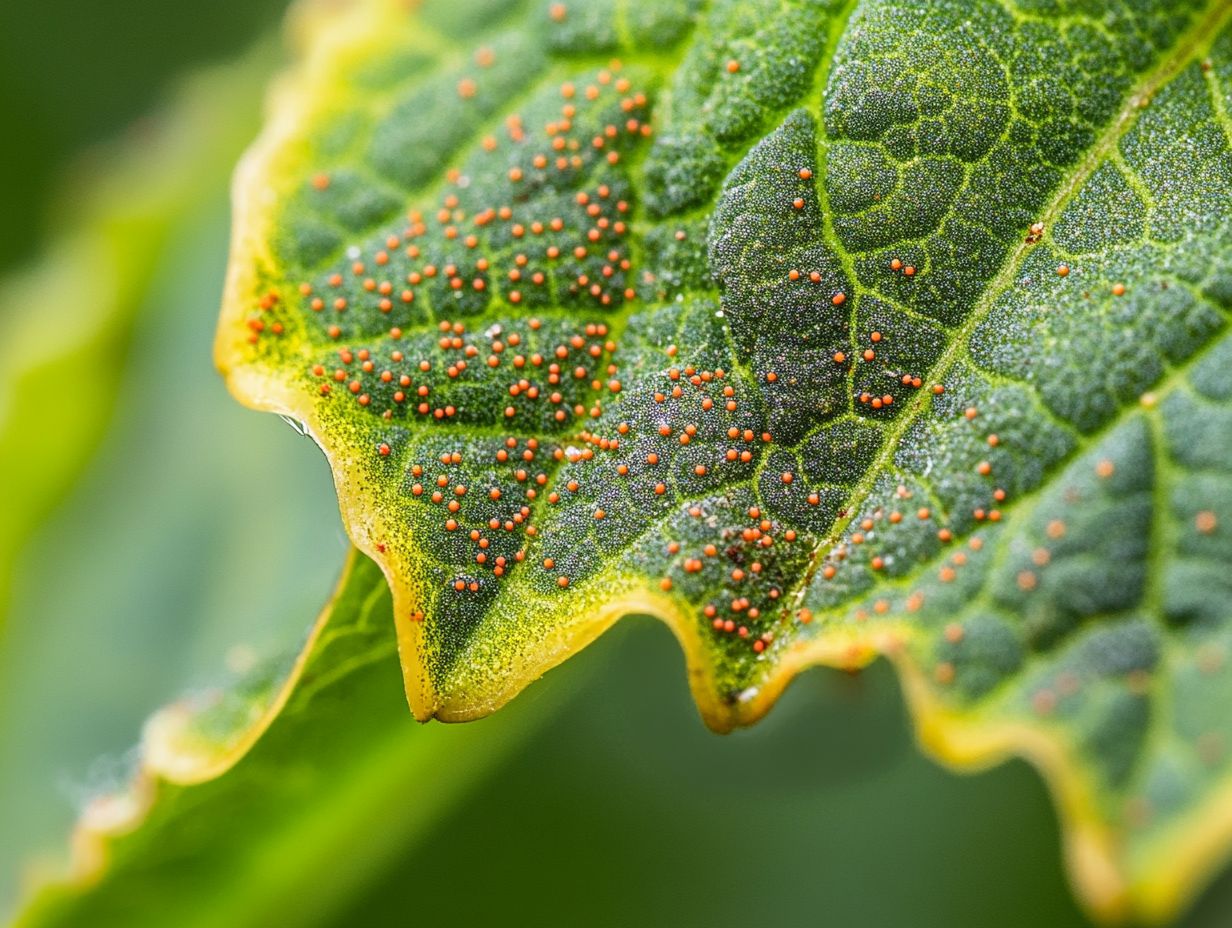
Identifying tiny mites on your plants is crucial for effective pest control. These minuscule invaders can cause significant harm, leading to serious spider mite damage if not addressed promptly.
Start by conducting a close visual inspection since these pests measure only 0.2 to 0.5 millimeters, making them nearly invisible without magnification. Spider mites can vary in color, appearing yellowish, light green, or even red. You may also notice fine webbing or speckled damage on the leaves as clear signs of an infestation. For more details, check the signs your indoor plant has pests.
Regular inspections are essential aim for at least once a week to catch any early signs of infestation. This proactive approach helps you address potential threats quickly, ensuring your plants remain vibrant and healthy.
5. Plant Leaves Become Brittle and Fall Off Easily
If your plant leaves become brittle and drop off with the slightest touch, it s a warning sign of severe spider mite damage. Act now to protect the health of your indoor plants and halt further decline.
These tiny pests feast on your plant s sap, weakening its structure and triggering concerning symptoms. As they puncture leaf cells, they extract vital nutrients, leading to yellowing and curling of the leaves.
Over time, your plants may struggle to make food from sunlight, resulting in stunted growth or even death. Inspect your plants regularly and consider introducing natural predators like ladybugs or lacewings into your indoor garden.
Maintain optimal humidity levels and clean the leaves regularly to deter these pests while promoting your plants’ overall health.
How Do Spider Mites Affect Indoor Plants?
Spider mites can wreak havoc on your indoor plants, damaging leaves, stunting growth, and creating an unhealthy atmosphere. Act now to protect your plants and seek effective pest control and natural remedies to preserve their vitality.
These tiny pests feast on your plants’ sap, causing yellowing leaves and fine webbing that can cloak the foliage. They thrive in warm, dry conditions and reproduce quickly, leading to a population explosion that stresses your plants. To ensure your plants are healthy, watch for symptoms like speckled leaves or premature leaf drop, which are clear indicators of severe feeding damage. For more insights, check the top signs of a healthy indoor plant.
Regular monitoring is crucial for tackling infestations effectively. Introduce beneficial insects like Amblyseius cucumeris or apply insecticidal soaps to ensure your plants not only survive but thrive in their indoor environment.
What Are the Common Types of Spider Mites?
You’ll encounter various types of spider mites, including the notorious two-spotted spider mite and helpful predators like Amblyseius cucumeris and Neoseiulus californicus. These beneficial allies are invaluable in your battle against spider mite infestations.
The two-spotted spider mite is easily recognized by its dark spots against a golden body. It can damage a wide range of plants with its feeding habits. To identify issues early, be aware of the top signs of indoor plant distress. Beneficial mites like Amblyseius cucumeris and Neoseiulus californicus help maintain a healthy ecosystem by preying on harmful mites and other pests, reducing your reliance on chemical pesticides.
By embracing these natural predators, you foster a balanced environment and ensure your plants receive the vitality and protection they deserve. Understanding the differences between these mite species will enhance your pest control strategy and improve your overall plant care.
How Do Spider Mites Spread and Infest Indoor Plants?
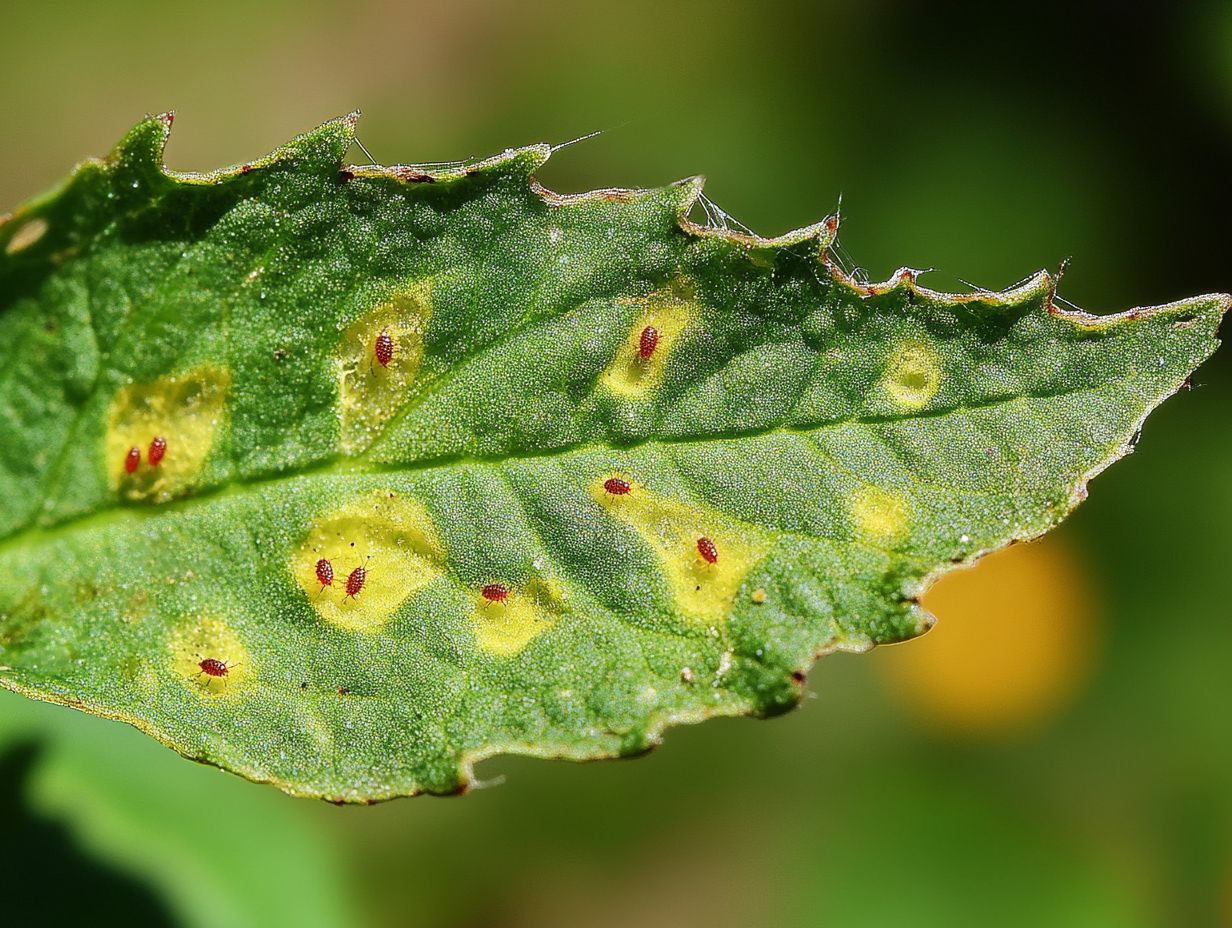
Spider mites have a knack for spreading and infesting indoor plants, primarily through transfer between plants. It’s crucial to quarantine new plants and practice diligent pest prevention measures to ensure a thriving indoor environment.
These minuscule pests flourish in warm, dry conditions. They can multiply at an alarming rate when the right factors like low humidity and high temperatures are present. They often hitch a ride on infested plant material, making it essential to inspect any new additions carefully.
Sharing pots or gardening tools can unwittingly transfer these pests, which underscores the necessity of thorough cleaning and disinfection.
To safeguard your indoor plants, make it a habit to monitor for signs of spider mites regularly. Consider implementing neem oil treatments and maintaining optimal humidity levels. Additionally, keeping an eye out for signs of nutrient deficiency can help ensure their health. These effective management strategies can significantly reduce the risk of an infestation.
What Are the Natural Ways to Get Rid of Spider Mites?
Natural methods for tackling spider mites in your indoor plants include using neem oil and horticultural oil. Both options effectively disrupt their life cycle while keeping your plants safe during treatment.
These oils operate by suffocating the mites and hindering their reproductive capabilities, making them a superb choice for environmentally conscious gardeners like you. To apply neem oil, mix it with water and a mild soap to improve its adherence to plant surfaces. Spray it directly onto the affected leaves, paying special attention to the undersides where spider mites often hide out.
Regularly inspecting your plants is essential during this treatment process. Frequent inspections help you gauge the effectiveness of your oil application and allow you to catch any new mite activity early on. This proactive approach ensures your plants stay healthy and vibrant.
What Are the Chemical Treatments for Spider Mites?
Chemical treatments for spider mites, such as BioAdvanced and Bonide, deliver immediate relief by targeting these pests while also considering the health of your indoor plants. It’s essential to consider systemic treatment options as well for a comprehensive approach.
To achieve the best results without harming your greenery, apply these treatments during the cooler hours of early morning or late evening. Spraying directly onto the affected foliage ensures thorough coverage, but be careful not to overdo it. Some plants may be sensitive to these chemicals, which could lead to leaf burn or discoloration. Always follow the label instructions closely, and it’s wise to conduct a patch test on a small area first.
If you seek gentler alternatives, options like insecticidal soaps and neem oil can be just as effective when used correctly, offering a more organic approach to pest control. You can also introduce Amblyseius cucumeris or Neoseiulus californicus to enhance your pest prevention efforts.
How Can One Prevent Spider Mites in Indoor Plants?
Preventing spider mites in your indoor plants requires a commitment to maintaining optimal humidity levels, regular leaf cleaning, and proactive pest prevention strategies that safeguard the health of your green companions. Isolate new plants to avoid spreading pests.
To effectively keep these pesky intruders at bay, regularly inspect your plants for early signs of infestation, such as webbing or tiny specks on the leaves. Additionally, recognizing stress signs in indoor plants can help you maintain their health. Increasing humidity can be as simple as misting your plants or placing a humidifier nearby, creating an environment that’s less inviting to spider mites.
Using gentle soaps or oils can help you remove any potential eggs or larvae without causing harm to your plants. By emphasizing a holistic approach to plant care, you’ll enhance their resilience against pests and promote their overall vitality and growth.
In this video, plant care expert Justin Hancock discusses the best practices for protecting Ficus religiosa and other popular houseplants.
Start monitoring your plants right away and consider these tips to ensure their health!
Frequently Asked Questions
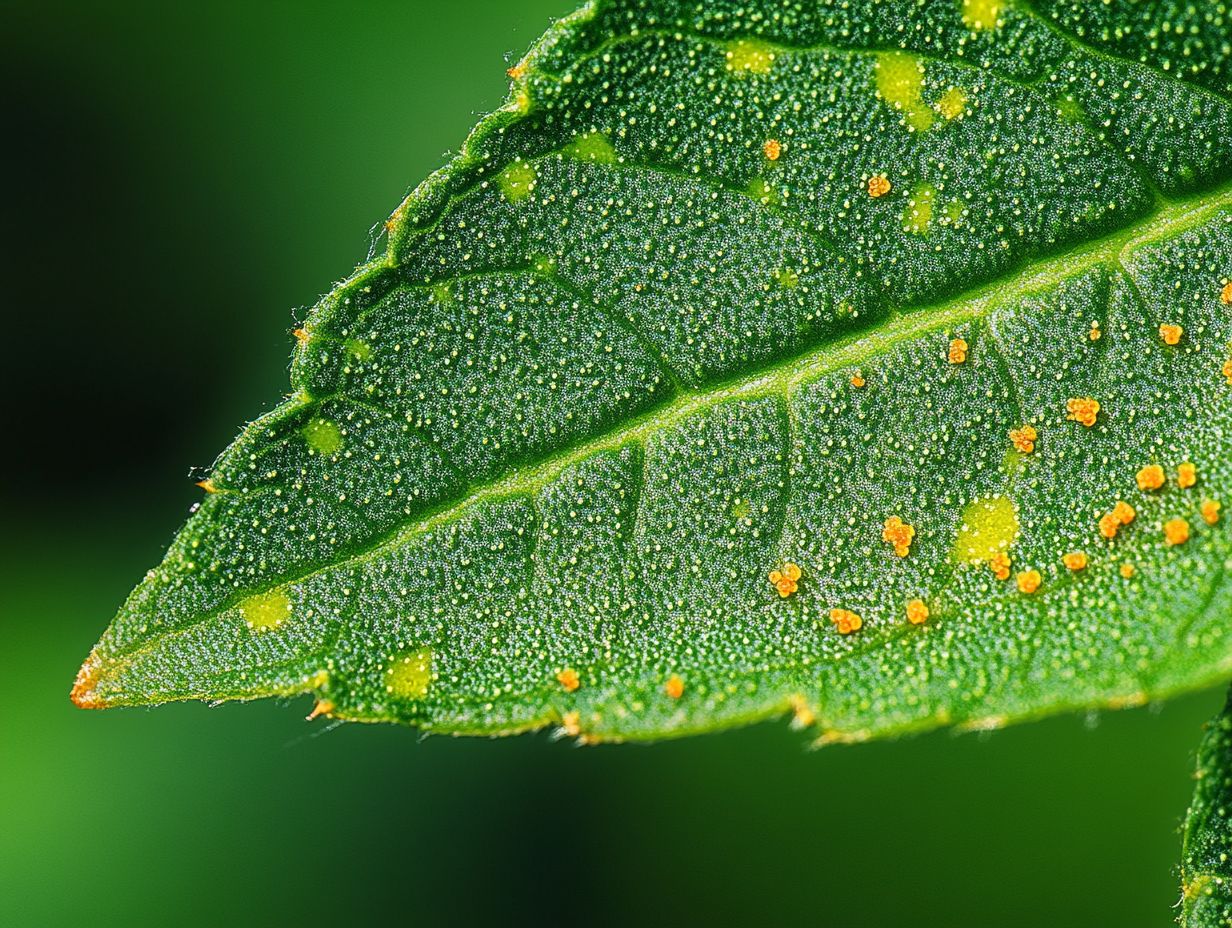
What are Spider Mites and Why They Harm Indoor Plants?
Identifying spider mites early is crucial to preventing extensive damage to your plants.
Spider mites are tiny pests related to spiders. They feed on the sap of plants, causing damage to leaves and potentially leading to plant death.
They can quickly infest indoor plants and cause significant damage if left untreated.
What are the 5 Signs of Spider Mites in Indoor Plants?
The 5 signs of spider mites in indoor plants include:
- Yellow or pale spots on leaves,
- Webbing between leaves and stems,
- Tiny moving dots on the leaves,
- Distorted or curled leaves,
- Stunted plant growth.
Recognizing these signs early can help protect your plants.
How Can I Confirm the Presence of Spider Mites in My Indoor Plants?
To check for spider mites, gently tap the underside of the leaves over a white piece of paper.
If tiny red or brown specks fall onto the paper, it indicates a spider mite infestation.
Can Spider Mites Spread to Other Indoor Plants?
Yes, spider mites can easily spread from one plant to another, especially if they are placed close together.
Isolating infested plants is essential to prevent the spread of these pests.
What is the Best Way to Get Rid of Spider Mites in Indoor Plants?
The most effective method to eliminate spider mites in indoor plants involves a combination of physical and chemical strategies.
You can manually remove the pests by wiping them off the leaves with a damp cloth. Then, use insecticidal soap, a natural spray that targets pests, or neem oil spray to kill any remaining mites.
How Can I Prevent Spider Mite Infestations in My Indoor Plants?
To prevent spider mite infestations, regularly inspect your plants for signs of pests.
Keep your plants well-watered and adequately fertilized. Also, avoid overcrowding.
Act quickly to protect your plants! Steer clear of bringing in new plants from unknown sources to minimize the risk of introducing spider mites to your indoor garden.
Don’t wait protect your plants today!

